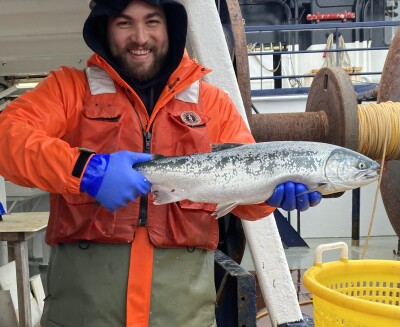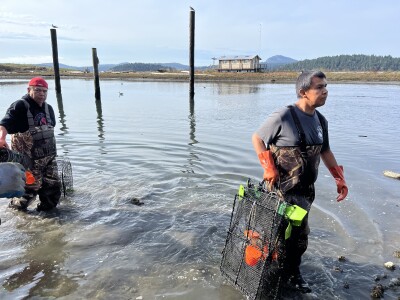Not buying it
By my calculations, there will soon be more seafood lists than there are varieties of fish. The most recent I have come across is "Canada's Sustainable Sushi Guide."
This list is for folks who are conflicted about their consumption of seafood, in this case served raw with cold boiled rice. If that isn't for you, or, conversely, if you plan to eat all you want no matter what I or anyone else has to say on the subject, you're probably not ready for the guide.
However, if you strive for eco-correctness in all things, the reassurance that a downloadable, wallet-size list packs could be just what the doctor ordered. (I ask only that you refrain from printing more than one copy, preferably on recycled paper.)
The sushi guide is produced by SeaChoice, "a comprehensive seafood markets program with the primary goal of realizing sustainable fisheries in Canada and abroad."
SeaChoice says it accepts only the best available science "to assess the status of stocks and the structure of the seafood supply chain."
In my view, however, there are flaws with the guide (which by no means distinguishes it from its predecessors). For instance, it admonishes us to avoid hotate — wild sea scallops — from Atlantic Canada, yet expresses only "some concerns" about scallops that have been caught in the same waters, but on the U.S. side of the Hague Line.
(It's OK to consume sushi about which the guide expresses concerns, particularly if we do so infrequently — say, when a more sustainable choice isn't available.)
I understand that the guide will indicate concerns about healthy species if habitat or bycatch are issues, but the significance of our maritime border with Canada is lost on me.
The guide expresses similarly befuddling concerns about kanikama — surimi — which finds its way into the imitation crabmeat that is a staple of Chinese restaurants.
Setting aside the question of what it has to do with sushi, surimi is for the most part derived from Alaska pollock, one of the ocean's most abundant species. In fact, fish sticks derived from Alaska pollock are a "best choice" on SeaChoice's non-sushi "Alert Card."
Yet we are admonished, when ordering imitation crab, to inquire what marine ingredient was used in the production of the surimi. I don't know about restaurants you frequent, but here in New England I seldom get a straight answer when I ask if the salmon is wild or farmed, or where the shrimp came from. I can't imagine getting into a nuanced conversation, with some guy whose worldly possessions amount to a green card and a pack of Marlboros, about the chain of custody of the surimi in the crab Rangoon.
And as Mr. T might have said, "I pity the fool" who tries to sort out the ebi — shrimp — situation: The guide advises us to avoid imported shrimp, farmed and wild, "except U.S.," and expresses concerns about farmed U.S. shrimp. If that sounds a little confusing, just get yourself some trap-harvested Nova Scotia shrimp, it's a "best choice." One question: Where (other than the obvious) does one get trap-caught Nova Scotia shrimp?
No matter how well-intentioned a seafood list is, it's probably not suited for use by anyone other than an eco-geek, and even then it is likely to be inconsistent, as we see with scallops, misleading, as we see with surimi, or bewildering, as we see with shrimp.
That said, consumers (and by extension, distributors) clearly want guidance about seafood consumption, hence the ascendancy of the Marine Stewardship Council, which distinguishes itself from the rank and file of advocacy groups by investing in research on the fisheries seeking the imprimatur of its label.
I've not been a champion of the MSC. I believe all fish harvested in accordance with the dictates of U.S. fisheries management are "best choices." One biomass may not be as large as another, but if quotas are set consistent with the best available science and the fishery is prosecuted consistent with the regulations, we ought not to censure the harvesters or the harvest.
Bycatch species are a legitimate consideration when evaluating fisheries, and there seems to be a broad notion that NMFS and the councils don't take bycatch into account. The record suggests otherwise. It's quite common for a bycatch limit to be reached before the total allowable catch for target species is achieved, in which case, the fishery shuts down.
Opposition to trawling is a political reality, but the MSC has not gone this route. There may be places unsuited to trawling — coral formations come to mind — but there's no body of data that I know of that quantifies destructive impacts from bottom trawling. Moreover, who's to say that every inch of seafloor should be consecrated?
In any event, if there were no MSC, someone would be inventing one. Markets are a force of nature, and as more and more fisheries perceive this they are seeking to ensure their acceptance by consumers.
Who knows? The MSC we've got may not be such a bad thing, if it evaluates fisheries on a real-time basis, by which I mean in the context of sustainable yield, bycatch and habitat impacts, and doesn't get enmeshed in rebuilding timetables and other zeitgeists, which tend to fluctuate, quite often in relation to each other.
–Jerry Fraser






